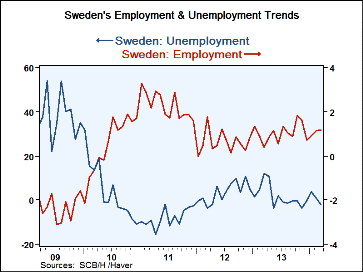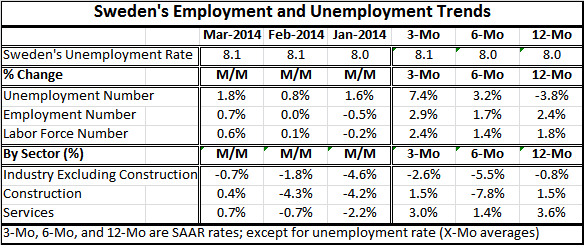 Global| Apr 22 2014
Global| Apr 22 2014Sweden Makes Employment Progress
Summary
Sweden continues to make progress on the employment front. In March employment improved by 0.7% after being flat in February and down slightly in January. Over three months, the employment growth rate is 2.9%, up from 2.4% over the [...]
 Sweden continues to make progress on the employment front. In March employment improved by 0.7% after being flat in February and down slightly in January. Over three months, the employment growth rate is 2.9%, up from 2.4% over the last 12 months. Unemployment is growing faster as the number of unemployed increased by 1.8% and it is growing at an annual rate of 7.4% over three months. Still, the number of unemployed is down by 3.8% year-over-year and progress continues to be made in reducing or containing the unemployment rate. The larger growth rate for unemployed doesn't necessarily swamp the smaller growth rate for the number of employed because the number of unemployed is so much smaller than the number of employed. As a result, Swedish unemployment has been very steady around 8.1% over various periods in the last 12 months. The labor force continues to grow; it rose in March by 0.6% and it is growing at a 1.8% rate year-over-year.
Sweden continues to make progress on the employment front. In March employment improved by 0.7% after being flat in February and down slightly in January. Over three months, the employment growth rate is 2.9%, up from 2.4% over the last 12 months. Unemployment is growing faster as the number of unemployed increased by 1.8% and it is growing at an annual rate of 7.4% over three months. Still, the number of unemployed is down by 3.8% year-over-year and progress continues to be made in reducing or containing the unemployment rate. The larger growth rate for unemployed doesn't necessarily swamp the smaller growth rate for the number of employed because the number of unemployed is so much smaller than the number of employed. As a result, Swedish unemployment has been very steady around 8.1% over various periods in the last 12 months. The labor force continues to grow; it rose in March by 0.6% and it is growing at a 1.8% rate year-over-year.
Employment gains in Sweden are predominantly in the services sector. In March service sector employment grew by 0.7%, employment grew by 0.4% in construction and it fell by 0.7% for industry excluding construction. The growth rate for jobs in industry excluding construction is -2.6% over three months, -5.5% over six months and -0.8% over 12 months. In recent months this segment of the labor market has not been doing very well recently. But the construction sector is doing somewhat better; it's up over three months, down over six months and up by 1.5% over 12 months. The services sector is where the steady drumbeat of jobs being created can be heard. Service sector jobs are up by 3.6% year-over-year; that drops back to a 1.4% pace over six months and it's back up to a 3% pace over three months. The services sector, which is the largest employment sector, is creating not only the bulk of jobs but showing the steadiest growth rate. Those are good signs for job prospects.
The chart shows trends in the growth rates of the number of employed and the number of unemployed. It's quite clear that the number of unemployed has been oscillating for some time around its zero line (zero rate of growth) maintaining its numbers. The number of unemployed was reduced in late 2010 to early 2012 then, until early 2013, there was a slight increase in the number of employed; since then, the numbers have hovered around zero with a slight tendency toward negative growth rates. The trends for employment show strong increases in 2010 and 2011 settling down in 2012 and from that point on showing steady but slight acceleration.
Sweden's labor market has made progress. But like the US economy, where the recovery is in a far more mature stage, it's clear that the recovery here has been weak as well. The good news is that the recovery is ongoing. Somewhat better news is that job growth is accelerating slightly. Despite this good news, the number of unemployed has been difficult to reduce. These sorts of labor trends are prevalent many countries in the wake of the financial market oriented recession. Still, as of March, Sweden is an ongoing recovery success if we judge it by the standards of the times.

Robert Brusca
AuthorMore in Author Profile »Robert A. Brusca is Chief Economist of Fact and Opinion Economics, a consulting firm he founded in Manhattan. He has been an economist on Wall Street for over 25 years. He has visited central banking and large institutional clients in over 30 countries in his career as an economist. Mr. Brusca was a Divisional Research Chief at the Federal Reserve Bank of NY (Chief of the International Financial markets Division), a Fed Watcher at Irving Trust and Chief Economist at Nikko Securities International. He is widely quoted and appears in various media. Mr. Brusca holds an MA and Ph.D. in economics from Michigan State University and a BA in Economics from the University of Michigan. His research pursues his strong interests in non aligned policy economics as well as international economics. FAO Economics’ research targets investors to assist them in making better investment decisions in stocks, bonds and in a variety of international assets. The company does not manage money and has no conflicts in giving economic advice.






